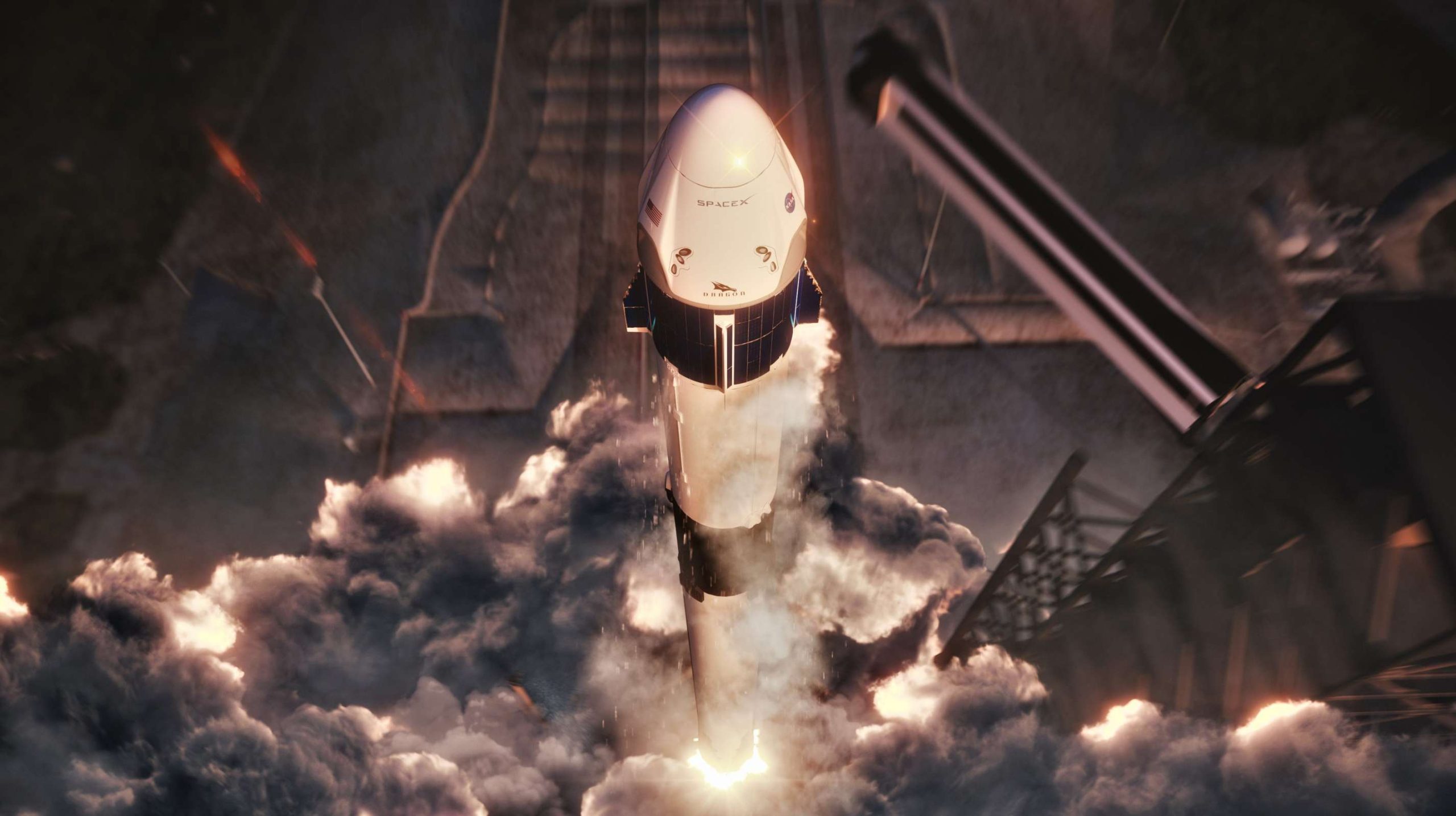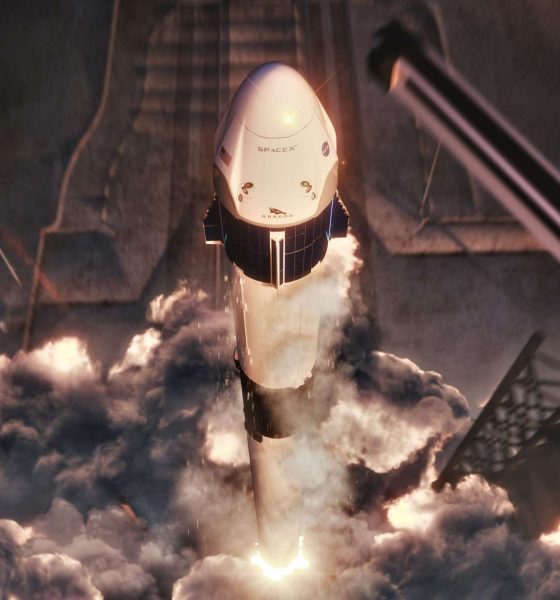

SpaceX
SpaceX given the go-ahead for Crew Dragon’s first journey into Earth orbit
NASA and SpaceX officials announced on Friday that the company is ready to conduct the first orbital launch of Crew Dragon as early as March 2nd, a demonstration that will directly precede the first crewed launch on a US rocket in more eight years.
Shortly after the news broke, NASA hosted what can only be described as an effusive press conference in which typically reserved officials like Bill Gerstenmaier and Kathy Lueders discussed the Commercial Crew Program milestone. Above all else, they reported no glaring concerns and rather unequivocally echoed the affirmation that SpaceX, NASA, Falcon 9, and Crew Dragon are all ready and eager to get to orbit. SpaceX now aims to roll the spacecraft and rocket out to the launch pad – Kennedy Space Center’s Pad 39A – on Thursday, February 28th, roughly 48 hours before T-0.
The Demo-1 Flight Readiness Review has concluded. The Board set March 2 at 2:48 a.m. EST as the official launch date for @SpaceX's flight to @Space_Station. #LaunchAmerica https://t.co/2DIJ99guG2 pic.twitter.com/86lV29gVNS
— NASA Commercial Crew (@Commercial_Crew) February 22, 2019
Relative to any number of recent NASA press conferences, the mood in the conference hall following the joint NASA-SpaceX Flight Readiness Review (FRR) was one of obvious relief and elation, marked particularly by heaps of praise and rare personal segues from Mr. Gerstenmaier (associate NASA administrator of Human Exploration and Operations) and Ms. Lueders, NASA’s Commercial Crew Program manager.
“We’re go for launch, we’re go for docking, and we’ll work through [one minor ISS partner concern] next week. But again, just a phenomenal review today … It’s great being back here again [and] starting to get that feeling of launching again and getting ready to go fly.” – Bill Gerstenmaier, NASA HEOMD, 02/22/19

“Right now, [we] do not have any open, joint risks [present on] this mission. It’s been part of our FRR process, and it was the reason why I could tell Mr. Gerstenmaier … that we [are] ready to go fly.” – Kathy Lueders, NASA CCP, 02/22/19
SpaceX Vice President of Build and Flight Reliability Hans Koenigsmann was equally enthusiastic about the completed review, describing his firm belief that – regardless of any delays it may have caused – the Crew Dragon spacecraft and its Falcon 9 rocket would ultimately be the best they could be as a result of the constant back-and-forth between NASA and SpaceX engineers and analysts.
The main mission objectives for DM-1: pic.twitter.com/i5rCKSQEDP
— SpaceXUpdates (@SpaceXUpdates) February 22, 2019
Aside from the encouraging FRR and follow-up press conference, SpaceX and NASA are reportedly planning on making the hosted webcast of Crew Dragon’s inaugural launch something fairly spectacular. While no specifics were given, this would come as no surprise knowing SpaceX’s past history of exceptional launch webcasts combined with CEO Elon Musk’s equal affinity to spectacular events. According to Koenigsmann, Crew Dragon will be outfitted with a mannequin (effectively an aerospace-grade crash test dummy) dressed in one of SpaceX’s in-house spacesuits, a globally-recognizable icon thanks to the widespread popularity of Falcon Heavy’s launch debut and special payload.
“The only work between now and launch is what we would consider standard work and [the] standard close-out of activities moving forward. So that shows you that we’re fully ready to go do this DM-1 flight next Saturday.” – Bill Gerstenmaier, NASA HEOMD, 02/22/19
The spacecraft will also apparently be nearly identical to DM-2’s Crew Dragon, the first vehicle that will fly with astronauts onboard. As such, it will presumably be outfitted with everything a crew of astronauts would need, including seats, a functioning control panel/display, lighting, and the general fit and finish of an interior ready to support a human presence for multiple days straight. Live camera views of both Starmannequin and out of Crew Dragon’s windows will thus be par for the course, among many other unique perspectives. SpaceX will also offer a rare hosted webcast for Crew Dragon’s arrival and docking at the International Space Station, scheduled roughly 24 hours after launch, an event that could potentially include exceptionally rare feeds from Dragon’s own onboard cameras.
Regardless, this is an event you do not want to miss. If all goes well during the Feb. 27 launch readiness review (LRR) and Falcon 9’s subsequent roll-out to Pad 39A, SpaceX will attempt its first Crew Dragon launch at 2:49 am EST (07:49 UTC) March 2nd.
Check out Teslarati’s newsletters for prompt updates, on-the-ground perspectives, and unique glimpses of SpaceX’s rocket launch and recovery processes!

Elon Musk
Elon Musk’s Biggest Revelations on AI, Robots, and the Future of Work from the Moonshots Podcast

Elon Musk’s appearance on the Moonshots with Peter Diamandis podcast was packed with bold predictions, candid admissions, and surprising tech insights. The nearly three-hour conversation covered everything from artificial intelligence to humanoid robots, geopolitics, and the future of work. Here are the top 10 most intriguing takeaways:
-
Aggressive AGI Timeline Predictions
Musk offered a detailed view on when artificial general intelligence (AGI) could emerge, suggesting it may arrive sooner than many expect, emphasizing both transformative potential and risks.
-
U.S. vs. China in the AI Race
He discussed the strategic competition between the United States and China over AI development, noting that geopolitical dynamics will shape how and who leads in the next decades.
-
Future of Job Markets
Musk touched on how AI and automation could reshape employment, predicting massive boosts in productivity alongside potential disruptions in traditional work structures.
-
Clean Energy Transition
A recurring theme was the role of clean energy in future economies, with Musk reiterating the importance of scaling sustainable power generation and storage.
-
Humanoid Robots Are Coming
On the podcast, Musk elaborated on Tesla’s work on humanoid robots, hinting at timelines and applications that go beyond factories to general-purpose assistance.
-
Tesla Roadster “Last Human-Driven Car”
Outside the core discussion topics, Musk teased features of the upcoming Tesla Roadster — calling it “the best of the last of the human-driven cars” and suggesting safety won’t be its main selling point.
-
The Role of AI in Clean Energy and Robotics
Linking AI to both energy optimization and robotics, Musk explained how smarter systems could accelerate decarbonization and task automation across industries.
-
U.S. Innovation Leadership
Musk argued that maintaining American leadership in key tech sectors like AI, space, and robotics should be a national priority, with thoughtful policy and investment.
-
Job Creation vs. Job Elimination
While acknowledging automation’s disruptive effects, he also outlined scenarios where new industries and opportunities could emerge, particularly in AI, space, and advanced manufacturing.
-
Long-Term Vision for Humanity
Throughout the conversation, Musk revisited his long-term philosophical views — including a belief in humanity’s responsibility to become a multi-planetary and technologically empowered species.
Whether you agree with Musk’s optimism or not, the podcast offers a window into the thinking of one of the most influential figures in tech today, in and why his visions continue to spark debate and inspiration.
Elon Musk
Starlink achieves major milestones in 2025 progress report
Starlink wrapped up 2025 with impressive growth, adding more than 4.6 million new active customers and expanding service to 35 additional countries, territories, and markets.

Starlink wrapped up 2025 with impressive growth, adding more than 4.6 million new active customers and expanding service to 35 additional countries, territories, and markets. The company also completed deployment of its first-generation Direct to Cell constellation, launching over 650 satellites in just 18 months to enable cellular connectivity.
SpaceX highlighted Starlink’s impressive 2025 progress in an extensive report.
Key achievements from Starlink’s 2025 Progress
Starlink connected over 4.6 million new customers with high-speed internet while bringing service to 35 more regions worldwide in 2025. Starlink is now connecting 9.2 million people worldwide. The service achieved this just weeks after hitting its 8 million customer milestone.
Starlink is now available in 155 markets, including areas that are unreachable by traditional ISPs. As per SpaceX, Starlink has also provided over 21 million airline passengers and 20 million cruise passengers with reliable high-speed internet connectivity during their travels.
Starlink Direct to Cell
Starlink’s Direct to Cell constellation, more than 650 satellites strong, has already connected over 12 million people at least once, marking a breakthrough in global mobile coverage.
Starlink Direct to Cell is currently rolled out to 22 countries and 6 continents, with over 6 million monthly customers. Starlink Direct to Cell also has 27 MNO partners to date.
“This year, SpaceX completed deployment of the first generation of the Starlink Direct to Cell constellation, with more than 650 satellites launched to low-Earth orbit in just 18 months. Starlink Direct to Cell has connected more than 12 million people, and counting, at least once, providing life-saving connectivity when people need it most,” SpaceX wrote.
Elon Musk
Starlink passes 9 million active customers just weeks after hitting 8 million
The milestone highlights the accelerating growth of Starlink, which has now been adding over 20,000 new users per day.

SpaceX’s Starlink satellite internet service has continued its rapid global expansion, surpassing 9 million active customers just weeks after crossing the 8 million mark.
The milestone highlights the accelerating growth of Starlink, which has now been adding over 20,000 new users per day.
9 million customers
In a post on X, SpaceX stated that Starlink now serves over 9 million active users across 155 countries, territories, and markets. The company reached 8 million customers in early November, meaning it added roughly 1 million subscribers in under seven weeks, or about 21,275 new users on average per day.
“Starlink is connecting more than 9M active customers with high-speed internet across 155 countries, territories, and many other markets,” Starlink wrote in a post on its official X account. SpaceX President Gwynne Shotwell also celebrated the milestone on X. “A huge thank you to all of our customers and congrats to the Starlink team for such an incredible product,” she wrote.
That growth rate reflects both rising demand for broadband in underserved regions and Starlink’s expanding satellite constellation, which now includes more than 9,000 low-Earth-orbit satellites designed to deliver high-speed, low-latency internet worldwide.
Starlink’s momentum
Starlink’s momentum has been building up. SpaceX reported 4.6 million Starlink customers in December 2024, followed by 7 million by August 2025, and 8 million customers in November. Independent data also suggests Starlink usage is rising sharply, with Cloudflare reporting that global web traffic from Starlink users more than doubled in 2025, as noted in an Insider report.
Starlink’s momentum is increasingly tied to SpaceX’s broader financial outlook. Elon Musk has said the satellite network is “by far” the company’s largest revenue driver, and reports suggest SpaceX may be positioning itself for an initial public offering as soon as next year, with valuations estimated as high as $1.5 trillion. Musk has also suggested in the past that Starlink could have its own IPO in the future.








